January 28, 2021 – Volume 23, Issue 1
In This Issue
-
Flanigan’s Eco-Logic: Messaging in 2021
- Microgrids 1.2: Today’s Components
- Video of Largest Corporate System in Orange County
- Tiny Houses
- EV Charger News
- Green Hydrogen: Offshore Wind Systems
- Residential Hydrogen Energy Storage
- China’s MagLev
- Pink Greenhouses
- Net Energy Metering 3.0 – CALSSA

Flanigan’s Eco-Logic: Messaging in 2021
Mom’s message to me was clear: The EcoNet newsletter is too heavy and complex. She told me recently, “Just wanted to report that I soldiered through the latest newsletter… most of which I do not understand.” Hmmm. I want to write in ways that she’ll understand, not just for those of us in a narrow slice of industry in which I work.
Excited to report that this past year’s issues of EcoNet News – Volume 22 – are now online in podcast format. For those interested, check out the NetPositive Podcast on our website under the Media tab. There’s a lot of inspiring content there. As I recorded the podcasts, I read and narrated, with my Mom’s “soldiering” in the back of my mind. I felt it too.
Yes, my sentences have become too complex. Mom recommends more periods. Reading the issues, I was winded. I love narration, but my presentation of these issues quite heavily researched and ripe with facts and figures, is too much to be efficiently digested. Many articles are too long.
I write this Eco-Logic not as a confessional, but a reminder to self, and to others. We strive to be clear in communication… simple and direct. “Gotta” remember the reader and to honor Comprehension 101. How can we communicate what’s really important to the listener succinctly? It’s not about being witty or exhaustive in research, but about tickling minds, curiosities, and interests!
My challenge for the year, this 23rd volume of EcoNet and my 36th year writing this newsletter, is to be less dense. Hopefully EcoNet will be a bit more inviting to you, our valued readers. But Mom, when you get to the NEM-3 article… you might want to stop after the third paragraph!
Quote of the Week
“California has surpassed its renewable energy targets.”
Webinar Highlight on the Role of Community Choice Aggregators in Surpassing California’s Renewable Energy Goals
Microgrids 1.2: Today’s Components
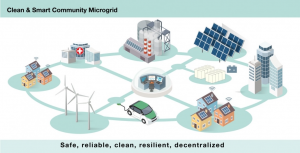
Photo Credit: The Climate Center
This second part of EcoMotion’s 10-part microgrid series digs into microgrid components: the hardware and the software that make up a new-age microgrid’s infrastructure.
There are three primary components to what I’ll call “green microgrids:” generation, storage, and controls. Smart providers – companies like Schneider and Scale – are working to provide these in pre-engineered packages. Let’s take them one by one.
The first component is generation. Microgrids can have a single source or multiple sources of generation. Early microgrids were generally powered with back-up generators. They were resilient for as long as their fuel supply lasted, be it a tank of diesel or natural gas. While the gas grid fails only about 1/20th of the time that the electric grids fail, it does fail. As such, there are natural gas generators on the market backed up with propane tanks… back-up to the back-up!
EcoMotion’s green microgrids generate and then operate on solar power, a renewable resource that keeps on giving. Paired with storage to ride through the night, solar provides an ongoing source of energy. In the Santa Rita microgrid story that we’ll tell in a future edition, each campus microgrid has solar arrays sized to power annual energy use.
The second component is storage. It is costly but enables microgrids to be powered with intermittent renewable power. Microgrids can operate using real-time power generation during the day, and then rely on stored energy at night. To reduce the amount of costly storage required, it makes sense to identify critical loads. These can be wired into a critical load sub panel which is powered on during an outage.
To size the storage – be it Tesla, LG, Samsung, Invinity batteries – we focus on the daily power requirement of the facility in emergency mode, and its critical power requirements. How many kilowatt-hours are required each day? How does this compare with solar generation throughout the year? (Naturally, winter production is low.) Microgrid storage sizing is based on the critical load, the anticipated solar generation, and the net requirement. Days with little sun will require a further reduction in emergency loads.
The third major component is the controls. They sound like a big deal, and they are in terms of functionality. In terms of size, however, microgrid controls are really small. A notebook computer may constitute the controls, but software is the name of the game. Some companies in this space like Geli only do software. They have developed proprietary “algorithms” that drive the controls and optimize on generation and storage and the grid interface.
Proprietary systems are programmed to address different use scenarios and optimize battery use: First, when the grid is fully functional, the controls are optimizing solar and storage daily. The microgrid is in sync with the grid, operating in parallel. By loading up the batteries with solar and discharging at costly peak periods… the controls are enabling energy arbitrage. Excess solar goes into the grid to be net energy metered, earning credits to be redeemed on the bill.
Now the grid goes down. This is a new use case. No longer in sync and parallel with the utility grid, the microgrid now is “islanded.” A switch/breaker safely disconnects the microgrid from the grid. That’s called the Point of Common Coupling. Now the system is running independently… a mode in which recharging the batteries with solar is key, as is staying within an energy budget for long-term resilience.
A well-designed and controlled solar + storage microgrid can operate indefinitely. Furthermore, these green microgrids are carbon-free and silent. They have day jobs that provide ongoing savings. They also have the potential to sell grid services in the future.
You can see why it’s easy to advocate for fully integrated, solar + storage microgrids! In our next brief in this Microgrid series, 1.3, we’ll continue to bring the microgrid concept to light with two very different examples of microgrids: Stone Edge Farms in Sonoma and Coop City in the Bronx.
Video of the Largest Corporate Solar System in Orange County
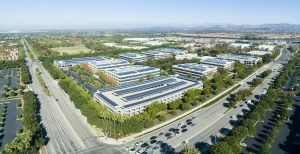 EcoMotion is proud of our Orange County client. With our guidance over the past decade, this global financial firm has invested in solar, and has now expanded its solar system in Irvine, California from 1.2 to 2.6 MW.
EcoMotion is proud of our Orange County client. With our guidance over the past decade, this global financial firm has invested in solar, and has now expanded its solar system in Irvine, California from 1.2 to 2.6 MW.
Each phase was cost-effective, and each phase was a big step in achieving the firm’s environmental goals. The campus is now covered with solar as documented in this new video:
The two-minute project snapshot video was produced by EcoMotion. Aerial footage was provided by One Zero Digital Media. Post-production services were provided by our longstanding video partner, Versatile Productions.
Tiny Houses

Photo Credit: Josiah and Steph Photography
U.S. homes are generally the world’s largest, and they’ve been growing in size. In 1973, the average new home was 1,660 square feet. By 2017 that size had grown to 2,631 square feet, a 63% increase. This spells increased energy use and greenhouse gas footprint, and a host of other impacts such as reducing green space and, in turn, habitat and biodiversity.
At the other end of the spectrum are tiny houses. They are exploding in popularity and are marked by ship-like innovation in compact living. They typically measure under 400 square feet. Advocates note that tiny house residents focus on quality, not quantity. In fact, studies have shown that residents’ behaviors change. In one study, “downsizers” cut their ecological footprints by 45%.
IKEA has partnered with Vox Creative and tiny home builder, Escape, to produce a tiny house on wheels. It’s 187-square feet in size, built as a trailer, and is topped with solar panels. It has white-washed interior wall panels made of sustainably grown pine and cupboards made from recycled bottle tops. It has a compostable toilet and an on-demand hot water heater. The home allows for off-the-grid living – zero pollution except when being towed! Models start at $47,550.
Here’s another application: The City of Redondo Beach is experimenting with providing Pallet Homes to people experiencing homelessness. It’s an idea from a Seattle company that makes industrial pallets. The tiny, 8 * 8-foot cabins were initially designed for disaster relief after Hurricane Katrina. They are made to store flat and assemble quickly. Each unit has bunk beds, shelves, heating, air conditioning, and electric outlets. They’re made of aluminum so they won’t rust and can be easily sanitized between users.
Riverside County, California has installed 30 Pallet Homes; residents are reportedly deeply grateful to have such fundamentals as a door and lock. Redondo Beach has now established its community of 15 Pallet Homes. The City will also provide counseling services to the residents there, as well as toilet and shower facilities.
EV Charger News
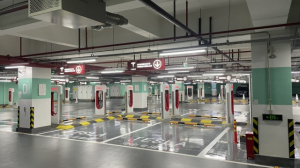
Photo Credit: Twitter User @JayinShangai
I am a proud graduate of the University of Vermont, with family roots in the Green Mountain State. Now get this… Vermont is the nation’s leading state in terms of EV charging. It has the highest number of public electric vehicle chargers per capita of any state in the nation.
The National Renewable Energy Laboratory has developed and updated the Alternative Fueling Station Locator. It provides information on public and private non-residential fueling stations in the United States. It tracks ethanol, biodiesel, compressed natural gas, EV charging, hydrogen, LNG, and propane stations.
As of November 2020, Vermont had 114 EV chargers per 100,000 people. Vermont was followed by Washington DC (81) and California (72). The next three states are Hawaii, Colorado, and Utah. In terms of the absolute number of EV charging stations and outlets, California leads the way, followed by New York, Florida, Texas, and Washington.
Tesla keeps on breaking its own records. In November it installed a 56-stall EV charging station in Firebaugh, California. Now it boasts an even larger facility, the world’s largest EV “gas station,” a supercharger station with a whopping 72 stalls. It’s located in the heart of Shanghai, inside the Jing’an International Center.
Tesla doesn’t rely on others’ EV charging networks. It has built its own supercharger network to optimize the Tesla ownership experience, and to enable long-distance EV driving. Recently Tesla announced that it had installed its 20,000th charger. It’s a “plug and charge” system. All the driver needs to do is plug in; the billing is handled automatically. Most of its stations charge at 120 kilowatts. (This compares to my household Level 2 charger at 7 kW.) Some of Tesla’s most advanced superchargers charge at 250 kW. That would fill my 60 kWh EV battery in fifteen minutes!
Green Hydrogen from Offshore Wind

Photo Credit: Diesel & Gas Turbine Worldwide
Many of us share a vision for hydrogen as a fuel to power a sustainable energy economy. Right now, hydrogen is used extensively in industrial applications worldwide. It is used for petroleum refining, treating metals, and producing fertilizer and chemicals such as ammonia. It is used in food production, hydrogenating unsaturated fats, and it is used by NASA for rocket fuel.
At this time, most hydrogen worldwide is produced using fossil fuels, largely natural gas. In fact, 6% of global natural gas consumption is for the production of hydrogen. Making hydrogen has a massive greenhouse gas impact: The International Energy Agency reports that hydrogen production is responsible for 830 million metric tonnes of CO2 each year, that’s nearly twice the United Kingdom’s footprint.
Wood Mackenzie reports that green hydrogen currently accounts for only 0.1% of worldwide hydrogen production. Given the carbon intensity of hydrogen today, and the climate emergency our global civilization faces, there is clear impetus for green hydrogen.
Two divisions of Siemens are teaming up to figure out how to generate hydrogen from wind turbines in the middle of the sea, and they are investing $146 million to do so. The project aims to drive down the cost of green hydrogen by building an offshore wind/green hydrogen system. The project will produce hydrogen on a floating platform adjacent to the offshore wind turbines. Each giant turbine will have a number of electrolysis modules to match the rated power of the turbine.
Residential Hydrogen Energy Storage
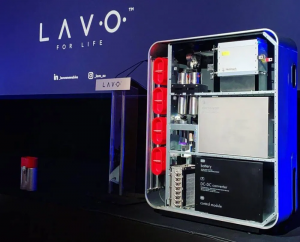
Photo Credit: Lavo
PowerWalls are now on notice! Some analysts call this, “A strident shot across the industry’s bow!” There’s a new energy storage technology vying for some space in your garage, namely hydrogen energy storage.
Lavo is an Australian company that uses hydrogen as a storage medium, versus lithium. Its Green Energy Storage System wraps together an electrolysis unit, hydrogen storage, and a fuel cell. The electrolysis unit generates hydrogen from water. Hydrogen is then stored in a tank. Later, a fuel cell converts the hydrogen back to electricity. Lavo units hold 40 kWh versus the Tesla PowerWall’s 13.5 kWh of storage. They cost more too: $26,900.
There are pros and cons of hydrogen storage systems: They will last longer than lithium-based systems, as they use hydrogen gas versus chemicals in batteries. They are more environmentally friendly, using less rare earth metals. Their big downside is a round-trip efficiency of 50%, far below that of lithium-ion batteries. That effectively ratchets down the unit’s storage size to 20 kWh. They’re also rather large – 5’6” * 4’ * 1.25’ in size – and weigh over 700 pounds.
China’s MagLev

Photo Credit: YouTube, “China’s 600km/h Maglev Train Prototype”
Magnetically levitated trains (maglevs) have many appealing features. They are fast, quiet, smooth, and efficient. Maglevs use magnets to repel and push the train up off the track. They float above the “tracks.” Another set of magnets is used to pull the train forward. The downside of maglevs is their cost. There are also concerns about excessive electromagnetic radiation.
China is to be credited for building and operating the world’s most significant maglev. Construction of the $1.3 billion line in Shanghai began in 2001. It connects Shanghai’s Pudong International Airport with the City’s financial district.
The line consists of 19 miles of track. The Shanghai Transrapid operates at speeds up to 267 mph. It is the fastest train in the world, and the only commercially operating maglev train in the world. Commercial service commenced in 2004, and the line has been operating since then.
One of China’s goals is to create faster transport links between major cities. Maglevs are part of this vision. Now an even higher-speed prototype is being developed that can run up to 385 mph. The 69-foot prototype maglev is being tested in the city of Chengdu in southwestern China’s Sichuan province of China.
Developers there hope to eventually boost the speed to 497 mph. This is made possible by using very low temperature superconductivity. That speed would transport passengers from Shanghai to Beijing in 3.5 hours. It takes two hours to fly the same journey, 5 – 6 hours on the existing bullet train.
Pink Greenhouses
In a novel experiment at Michigan State University, horticulturalists and facilities managers have come together to find common ground: The researchers want optimum light for plant growth; the facility operators want maximum efficiency. LEDs (light emitting diode) lamps have cut power consumption by 50% in the greenhouses. Now researchers have found that red fixtures are the most cost-efficient at converting electricity into the light plants use for photosynthesis. So, the greenhouse has a mix of red and white LED lamp fixtures, saving energy and optimizing on plant growth. The researchers also found that the plants need a splash of blue light, which is provided by a small number of blue-light emitting LEDs. The overall result… greenhouses that glow pink.

Photo Credit: Reddit
Net Energy Metering 3.0 – CALSSA
Thanks to the California Solar and Storage Association (CALSSA) for a most informative webinar on the regulatory process in California that will lead to Net Energy Metering 3.0. We salute CALSSA’s work in supporting distributed solar and storage and thank Brad Heavner for his astute perspectives and efforts.
Let’s begin with the basics: Net energy metering (NEM) allows homeowners and business owners to install solar and to send excess generation to the grid. It’s a bright sunny summer day… lots of solar. You’re generating more solar power than you can use. You send it to the grid and get credit at exactly the price you would have had to pay to buy that much power. You are getting 100% of the “retail rate.” Then in the dark and short days of winter your solar system is producing less than you use, so you draw power from the grid and expend your credits. The grid has allowed this.
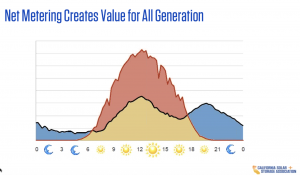
The graph above shows a typical sunny day. You can see that there’s lots of solar generation represented in red and yellow. The mountain of solar generation is way above the yellow shaded area that represents actual site use. The solar you use onsite (the yellow area) is “behind the meter.” It’s under your control. It’s valued at the full retail rate, the price that you would have paid your utility if you did not have solar.
The area shaded red is the situation in question: That’s the amount that you “export” to the grid on those sunny days of summer. Fully 50% of all the solar kilowatt-hours generated by residential customers is “exported” to the grid through net energy metering.
Naturally, consumers want to maintain NEM as is. It’s a great deal that allows us to generate 100% of our annual usage and not at the same time as we use it. Utilities claim that this use pattern represents a subsidy paid by all ratepayers. Utilities want to pay far less for that power. It is much more than they pay for utility-scale solar or any other generation.
As it is in other states, NEM in California is at a crossroads. It’s at a tough regulatory spot: The less value that solar owners get for the red area, the lesser the ROI, the longer the payback. Cutting the NEM value will impact the solar industry, retard job growth and economic development, and slow cities’ progress with climate action. Certainly, the economics of California’s Title 24’s solar requirement for all new homes is in jeopardy.
California has just opened a regulatory proceeding on Net Energy Metering 3.0. CALSSA’s regulatory specialist, Heavner, expects a ruling as soon as November of 2021, and implementation of the rule as early as the second quarter of 2022.
CALSSA’s policy goal and challenge are to get regulators and their utilities to continue to grow and support the solar and storage market. CALSSA and its members want the State to encourage solar interconnections through net energy metering that provides great value to solar system owners. CALSSA wants jobs, economic development, health, and resilience benefits to be factored into NEM-3.
A bit of history: California’s first NEM in 1995 was a limited program for residential customers only and for solar systems less than 10 kW in size. The program was capped at 0.1% of peak demand, or 53 MW statewide. In 2001, the program was revised to allow for systems as large as 1 MW.
Shortly thereafter, the cap was raised from 0.1% to 0.5%, boosting solar capacity allowed to 270 MW. Then SB1 in 2006, the bill that launched the California Million Solar Roofs initiative, raised the cap from 0.5% to 2.5%. In 2010, the cap was raised from 2.5% to 5%. In 2012, the CPUC elected to use a different calculation of peak demand which effectively doubled the cap in terms of megawatts allowed.
In 2016, NEM-2 was ordered into effect by the Commission. At the time, it made clear that this was an interim decision and NEM-3 proceedings would take place in 2019. NEM-3 would be based on deep analysis of NEM-1 and NEM-2 and would seek to resolve key issues not addressed in NEM-2.
NEM-2 has several features of note: First, it lifted the amount of solar that a company could put onsite – there’s even been a 13 MW, NEM system. NEM-2 instituted the collection of non-by passable charges (NBCs) at a cost of 1.5 – 2 cents per kilowatt-hour of net metered solar. It also made time-of-use rates mandatory for solar customers.
NEM-2 made clear that municipal utilities were not required to go beyond the 5% cap. In fact, a number of municipal utilities have already hit the 5% mark: Merced, Imperial, Palo Alto, Alameda, and Redding. Despite CALSSA’s efforts, none are strongly advocating additional distributed solar. Anaheim Public Utilities has instituted a “Annual Cash Compensation Rate” for exported power which is essentially a wholesale rate. Even Sacramento Municipal Utility District is reportedly holding back from full support of distributed solar.
Proposals for NEM-3 are due from stakeholders in March. Stay tuned. CALSSA cautions the State not to follow the path of Hawaii and Nevada, both of which submarined their solar industries.
We do have insights now: Heavner says that many of the issues and a variety of solutions were put on the table a few years ago in the NEM-2 proceeding:
Some argued for utilities to pay solar customers an “export credit” instead of the retail rate for the area in red. (Export credit rates of 4 – 9.7 cents/kWh were proposed.) And/or, utilities could charge a fixed monthly fee or demand charges for interconnection and NEM. Another design option considered is for monthly NEM true-ups instead of annual true-ups and thereby disallowing seasonal banking of NEM credits.
The most far-out concept is that utilities could charge customers for all of their solar generation, even heretofore sacrosanct “behind-the-meter” solar. That’s the area in yellow that has always been considered “yours!” A charge of 2.4 cents was proposed.
Another intriguing option is “Buy All / Sell All,” whereby a solar customer would have two meters: one to measure how much solar energy is generated, the other measuring the site load. Naturally, utilities want to pay wholesale rates for generation while charging retail rates for consumption. Stakeholders have also looked at locational values for solar generation.
Summing it up: The biggest NEM-3 factor is the basic financial deal. Will there be an export compensation rate? Will there be fixed monthly charges for grid access? What about Buy-All, Sell All? Will specific rate requirements be tied to NEM-3? Will those that get it, get it for 20 years as has been the case for NEM-1 and NEM-2? What will the “glide path” look like from NEM-2 to NEM-3? How long will the phase in be?
Complicating matters greatly is the energy storage. Will solar + storage systems require a different tariff? One separate from solar? There are big questions about NEM-solar paired with storage. At this time, you can get NEM credit for export from storage if the storage is filled with solar electrons, and you can prove it. The more punitive the CPUC’s decision on storage, the more likely that there will be grid defection, with customers cutting the utility cord and relying solely on their own systems.
CALSSA presents the reality that in the coming years, the economics may be quite different. The Self Generation Incentive Program is slated to expire. It may get refunded, but it hasn’t yet. The Investment Tax Credit will step down. And if a restrictive NEM-3 hits the market. Ouch!
Examples from around the world of successful solar adoption have depended on rates even higher than retail, like Germany’s Feed-In Tariff. To retreat far short of retail values is heading in the opposite direction.
